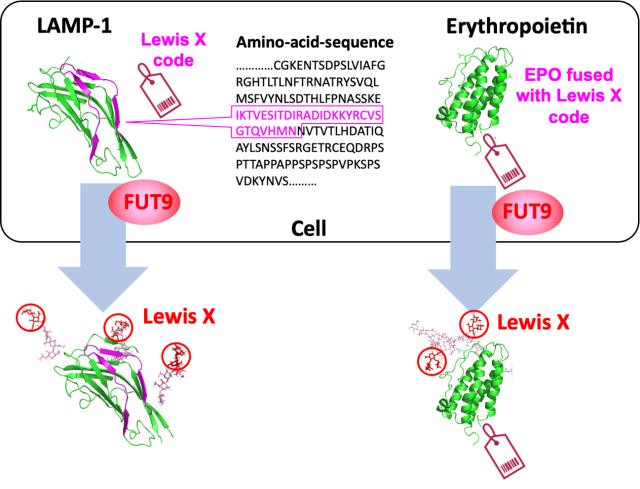Collaborative research groups have discovered a regulatory code of glycosylation in protein. Furthermore, they have demonstrated that the incorporation of this molecular code can be embedded into other glycoproteins serving as biopharmaceuticals to control their glycosylation.
Many proteins in nature exist as glycoproteins, which consist of protein (polypeptide chain) and glycan (sugar chain). The protein structure is determined on the basis of its genetic blueprint, but the information on glycans is not directly encoded by the genome. Therefore, it is difficult to control protein glycosylation. Under these circumstances, a collaborative research group, including researchers at Nagoya City University, National Institutes of Natural Sciences, and Academia Sinica, has found a specific amino acid sequence in a polypeptide that induces a specific glycan structure called Lewis X.
The researchers in Japan have previously shown that Lewis X specifically modifies the protein LAMP-1 in mouse neural stem cells through the enzymatic action of fucosyltransferase 9 (FUT9). In this recent study, they have shown that Lewis X modification specific for LAMP-1 occurs not only in neural stem cells but also in several cultured mammalian cells. Furthermore, they have found that a sequence consisting of 29-amino-acid residues in LAMP-1 promotes Lewis X modification catalyzed by the enzyme, and this sequence induces Lewis X modification when fused to other proteins used as biopharmaceuticals. This means that, in glycoprotein molecules, a specific amino-acid sequence can determine their glycan structures.
Most of biopharmaceuticals are glycoproteins, as best exemplified by therapeutic antibodies. Their glycan structures are critical for their efficacy and safety. Therefore, the control of glycosylation is an important issue in the development of biopharmaceuticals. Their findings on a regulatory code of protein glycosylation are expected to pave the way for controlling glycosylation of biopharmaceuticals.

Reference
Journal:
Communications Biology
DOI:
10.1038/s42003-022-03616-1
Airticle title:
An embeddable molecular code for Lewis X modification through interaction with fucosyltransferase 9
Airticle publication date :
13-July-2022
Eurekalert! URL:https://www.eurekalert.org/news-releases/958537
Contact
Expert contacts:
Hirokazu Yagi
Nagoya City University
hyagi_at_phar.nagoya-cu.ac.jp
Office: 81-52-836-3448
Koichi Kato
Exploratory Research Center on Life and Living Systems (ExCELLS), National Institutes of Natural Sciences
kkato_at_excells.orion.ac.jp
Office: 81-564-59-5225
(Please replace the “_at_” with @)
Funder
Grants-in-Aid for Scientific Research
JP20K21495, JP21H02625, JP24249002, JP17H06414, and JP25102008
Japan Science and Technology Agency
JPMJCR21E3

